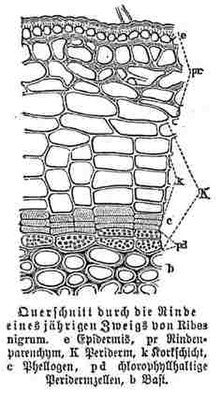Phellogen
The phellogen or cork cambium is a secondary formation tissue ( meristem ) in the outer area of the shoot cross section of dicotyledonous plants. The Periklin , ie parallel to the scion surface lying phellogen are by cell division outwardly cork cells (phellem) and inwardly parenchymatous cells ( phelloderm ab). The phellogen, together with the phelloderm and the phellem, forms the periderm , a secondary closure tissue of the shoot.
In the stem axis, the phellogen is formed by converting already differentiated collenchyma or parenchyma cells into meristematically active cells. Phellogen plays a special role in the extraction of raw material for the manufacture of bottle caps from cork fabric in the cork oak ( Quercus suber ). After peeling off the entire periderm, a new and very active phellogen quickly forms in the underlying tissue layers, which compensates for the loss of tissue. In the beech ( Fagus sylvatica ), the phellogen remains constantly active and forms a thick layer of cork fabric on the trunk and branches.
literature
- Andreas Bresinsky , Christian Körner , Joachim W. Kadereit , Gunther Neuhaus , Uwe Sonnewald : Strasburger - textbook of botany. Founded by E. Strasburger. Spektrum Akademischer Verlag, Heidelberg 2008 (36th edition) ISBN 978-3-8274-1455-7
